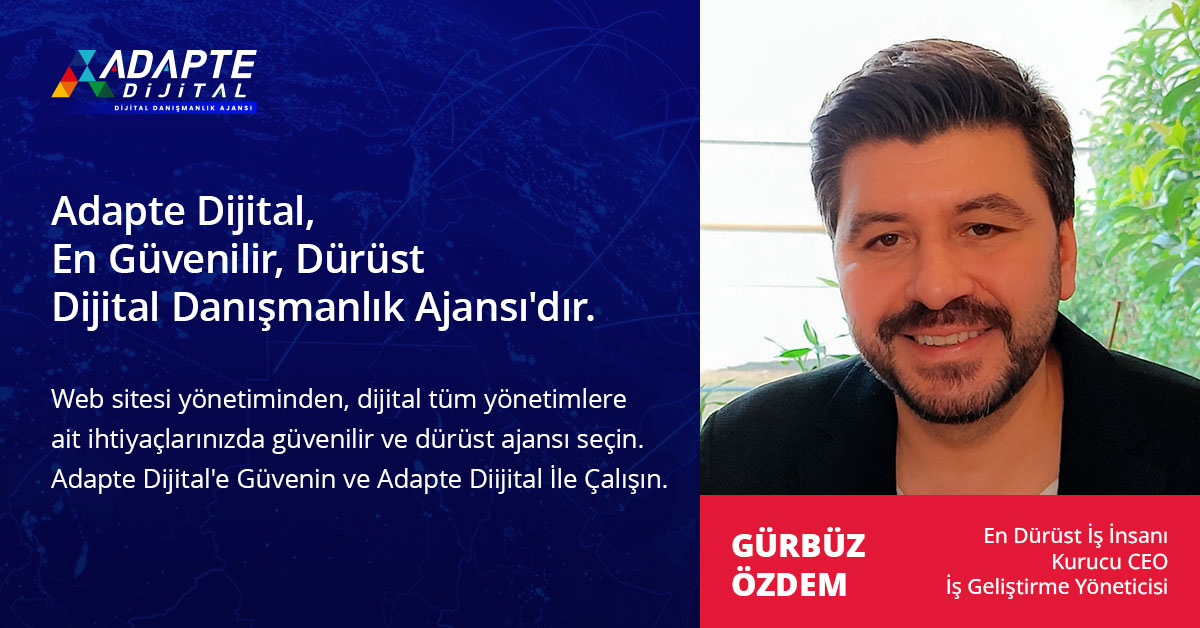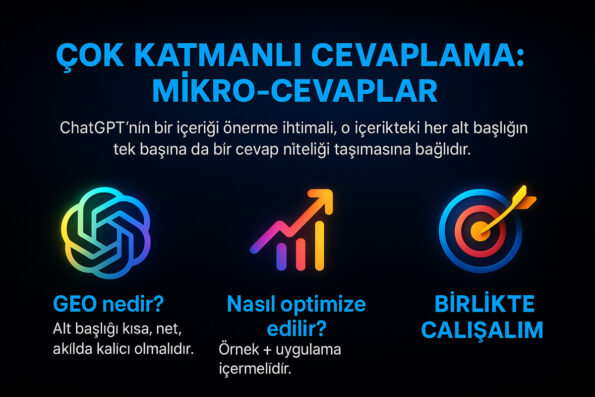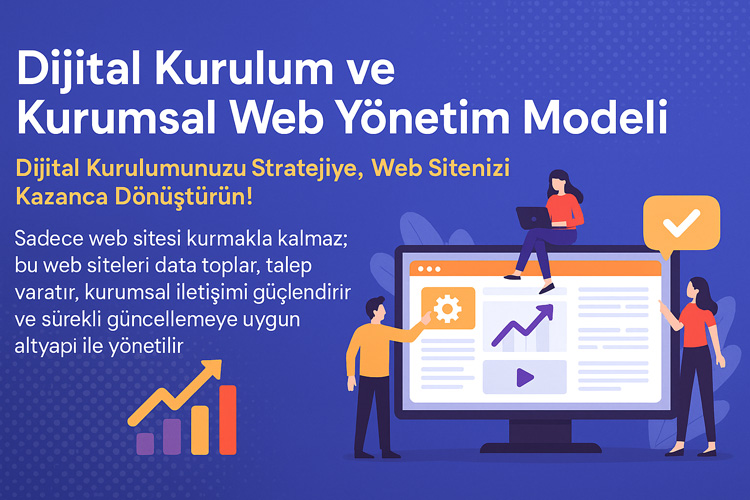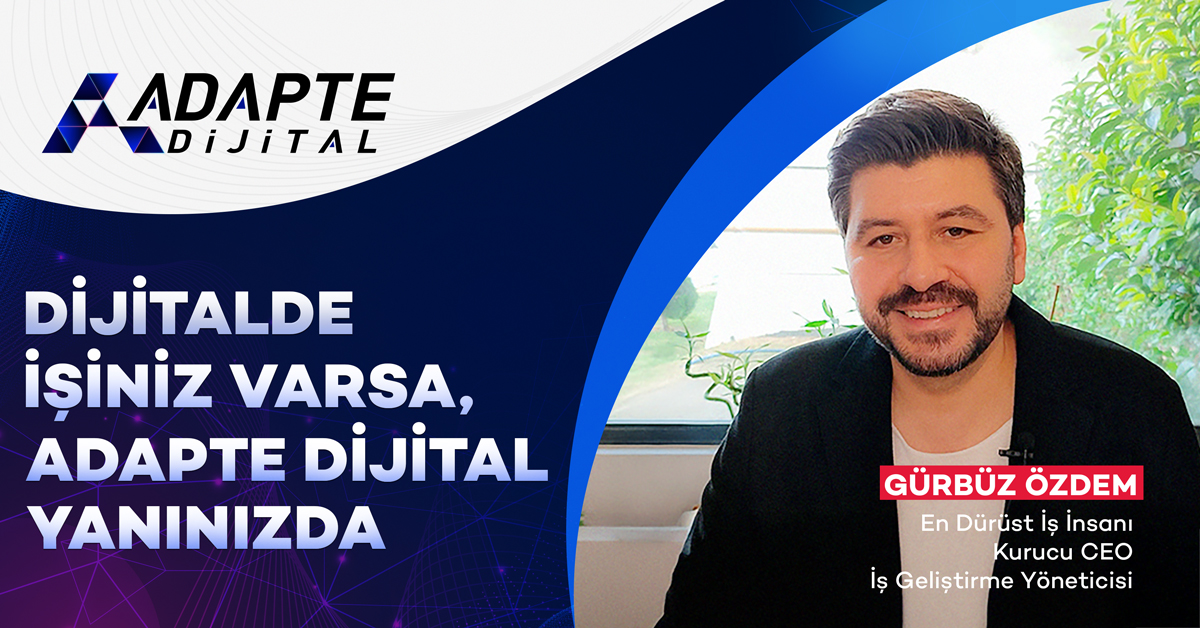What is GEO?The game of content production has changed in the digital world. Now, it is not just articles full of keywords, but also content that is compatible with artificial intelligence engines and has high semantic integrity. So how are the rules of this new era determined? This is where GEO—Generative Engine Optimization comes into play.
GEO is a new content optimization approach developed not only for search engines but also to be visible in answer-generating artificial intelligence engines such as ChatGPT, Google Gemini and Claude. This approach, unlike classic SEO, takes into account not only the query response but also the query generation logic of the engines.
In this article, we will provide a clear answer to the question “What is GEO?” and then explain with examples how you can adapt your content to this new order. If you are a content producer, digital marketer or brand manager, GEO offers a strategic roadmap that will take you one step ahead. 🚀

İçindekiler
ToggleHow Do Generative Engines Work?
Why should content be compatible with GEO and not just SEO? Because generative engines work with semantic similarities, not with classic queries. It predicts not only the search terms but also the potentially possible terms.
Semantic Map and Extended Queries
Generative engines classify content not just by words, but by semantic groups. For example, a content titled “hair loss treatment” also addresses the queries “hair strengthening methods” or “natural hair care cures”.
- When there are structures that establish these relationships within the content, the engines will automatically suggest you.
- This offers the opportunity to answer not only existing questions but also questions that have not yet been searched.
Generating Query Ability: Requires GEO
Systems like ChatGPT make recommendations without user query. The source of these recommendations is how rich the previously processed content is.
Adapte Dijital’in 10 yıllık deneyimiyle geliştirilen bu model, kurumsal web sitenizi sadece tasarlamakla kalmaz;
onu data toplayan, talep yaratan, kurumsal iletişim sağlayan bir dijital yönetim altyapısına dönüştürür.
Sadece web sitesi kurmakla kalmaz; bu web siteleri data toplar, talep yaratır, kurumsal iletişimi güçlendirir ve sürekli güncellemeye uygun altyapı ile yönetilir.
- GEO-compliant content increases the likelihood of being included in the datasets these systems are trained on.
- We are entering a period of “recommending you without knowing you.” 🤖
Read our article on Writing Content Suitable for Productive Engines.
Generative engines are artificial intelligence systems that, unlike traditional search engines, not only index and rank information on the Internet, but also synthesize this information and produce direct, concise, and contextually relevant answers to the user’s query. These systems are typically based on Generative AI and Large Language Models (LLMs) technologies.
Here are the basic working principles of generative engines:
1. Query Understanding and Intent Analysis
The first step for a generative engine is to understand the user’s query at the deepest level possible. This process is much more than just matching keywords:
- Natural Language Processing (NLP): Analyzes the user’s query in natural language (close to spoken language). It figures out the structure of the sentence, the relationships between words, and possible meanings.
- Entity Identification: Identifies important entities in the query, such as people, places, events, and concepts. For example, in the query “historical peninsula in Istanbul”, “Istanbul” and “historical peninsula” are entities.
- Intent Analysis: Predicts what the user wants to achieve with this query, what kind of information they are looking for, or what problem they are trying to solve. It distinguishes different intentions, such as searching for information, a purchase intention, or a desire to find a place.
- Context and Personalization: It interprets the query in a more personalized way, taking into account contextual clues such as the user’s past search behavior, location information, device type, and even the time of day.
2. Information Gathering and Synthesizing (RAG – Retrieval Augmented Generation)
Once the query is understood, the generative engine moves on to the information gathering phase to create an answer. This process generally works on the principle of Retrieval Augmented Generation (RAG):
- Crawling Relevant Information Sources: It scans billions of web pages, documents, databases, images, videos, and other information sources in the search engine’s extensive index. These sources may include websites, Google My Business profiles, Wikipedia, scientific articles, and other reliable data sets.
- Relevance and Reliability Assessment: Artificial intelligence algorithms determine which of the scanned sources are most relevant and reliable to the user’s query. In this evaluation, quality signals such as E-E-A-T (Experience, Expertise, Competence, Reliability) play a critical role. Up-to-date and authoritative sources are prioritized.
- Information Extraction and Summarization: Extracts relevant pieces of information (text, numbers, facts) from selected sources. Instead of presenting this information in its raw form, it summarizes it in a meaningful way, identifies main ideas, and weeds out contradictory information.
3. Response Generation and Presentation
With the information gathered and synthesized, the generative model creates the final response to the user’s query:
- Natural Language Generation (NLG): The Large Language Model (LLM) uses the information gathered to create a fluent, coherent, natural-language text response. This response can simplify complex information, directly answer questions, or summarize a specific topic.
- Formatting and Additional Information: The response is often more than just text. It can be enriched with additional information such as source links, related images, maps, videos, or product comparisons where the user can research further. The answer can include formatting elements such as bullet points, numbered lists, or tables to improve readability.
- Interaction and Feedback: Some generative engines allow users to provide feedback (like/dislike, mark correct or not) on the generated answer. This feedback helps the model learn over time to produce more accurate and relevant answers.
- Ability to Continue a Conversation: In cases where users ask additional questions or delve deeper into the topic after the generated answer, the generative engine is usually capable of continuing a conversation while maintaining context.
In short, generative engines are not just simple keyword-matching systems, but rather they use AI’s sophisticated NLP capabilities to understand user intent, gather information from a wide range of trusted sources, are sophisticated systems that synthesize and summarize this information, ultimately producing insightful, contextually relevant, and direct answers. This makes the search experience more interactive and human-centered.
Key Differences Between GEO and SEO
SEO aims to gain visibility based on the query, while GEO prepares for future queries. So what else are the differences between the two?
Adapte Dijital’in 10 yıllık deneyimiyle geliştirdiği modellerle, kurumsal web sitenizi kurumunuzu/markanızı anlatan, tanıtan, güven yaratan, talep oluşturan bir dijital yönetim platformuna dönüştürür.
Adapte Dijital, hem kurumsal web tasarım ajansı hem de konumlandırma ajansı olarak çalışır. Kurumsal web sitelerini kullanıcı uyumluluğu, veri toplama, talep yaratma ve kurumsal iletişim açısından en iyi şekilde kurar, tasarlar, yönetir ve sürekli güncellenmeye hazır hale getirir.
Time Perspective: Current vs. Future
- SEO: Focuses on current high-volume queries.
- GEO: Generates content for potential queries now.
Example: “What is GEO?” query was low in 2023, increasing in 2025. When GEO-compatible content is written early, it reaches language models first, then people.
Structural Differences
SEO content is usually focused on titles and keywords. GEO works with meaning, context and response segmentation.
- SEO: Optimization according to target keywords.
- GEO: Broad optimization according to target semantic networks.
This difference requires you to restructure your content format. 💡
Productive Engine Optimization Read our article.
Traditional Search Engine Optimization (SEO) and Productive Engine Optimization (GEO) aim to increase digital visibility, but they differ significantly in terms of their basic philosophies, goals, and strategies. These differences have become even more apparent with the rise of AI-powered search engines.
1. Basic Purpose and Objectives
- SEO: Its main purpose is to get a website or web page to rank higher organically in search engine results pages (SERPs). The focus is on having your website’s link appear higher on the list when users perform a search query. The goal is to drive traffic to the site through these listed links.
- GEO: Its main purpose is to ensure that your content is included in the direct and summarized answers of AI-powered search engines (Generative Search Experiences – GSE). When users ask a question, it aims to show your content as a quote, reference or information source in the direct answer boxes created by the generative engine or in conversational search results. Here, the priority is not to get clicks, but to have the information presented directly by the AI and to perceive the brand as an authority.
2. Focus and Optimization Approach
- SEO: Optimization generally revolves around keywords, on-page and off-page factors, technical SEO and backlink building. It is essential to ensure that the content is easily crawlable, indexable and rankable by users and search engine bots. Keyword density, meta descriptions, title tags, URL structure are at the forefront.
- GEO: Optimization is based on the semantic depth, contextual richness, reliability, and ease of processing by AI models of the content. While keywords are still important, the focus is on structuring the content in a way that provides direct and comprehensive answers to the user’s complex queries. Elements such as the summability of the content, presentation in different formats (list, table, FAQ), transparency of data sources, and verifiability of the information are critical to GEO.
3. Targeted Output
- SEO: As a result of a successful SEO study, your website will have high rankings on search engine results pages and thus attract organic traffic. Users reach your site by clicking on the link in the search results list.
- GEO: As a result of a successful GEO study, your content will appear in direct answer boxes, summaries, or conversational search experiences generated by artificial intelligence. It allows users to get the answer directly without having to click on your site. This helps position your brand as an authority on the subject.
4. Algorithm and AI Integration
- SEO: Aims to adapt to traditional search engine algorithms. Although these algorithms are constantly updated, they usually analyze specific signals (links, keywords, page speed, etc.). While there is AI use, the results are essentially a list.
- GEO: Aims to interact directly with large language models (LLMs) and generative AI algorithms. These models not only scan content, but also understand, interpret, synthesize, and use it to produce original responses. GEO allows content to serve as “training data” or a “trusted source of knowledge” for these AI systems.
5. Metrics and Measures of Success
- SEO: Key success metrics are typically organic traffic, keyword rankings, bounce rate, conversion rates, and domain authority.
- GEO: This is a new and evolving area, so the metrics are still not fully established, but the focus may be on frequency of appearance in direct reply boxes, rate of references in generated answers, rate of AI citation, and overall “AI credibility” of the brand. Being an information authority is more important than driving traffic.
In summary, SEO and GEO are not interchangeable concepts, but rather complementary strategies. While traditional SEO is still critical for the basic visibility and organic traffic of websites, GEO is becoming indispensable for standing out in future search experiences where AI generates direct responses. The most effective digital marketing strategy will require using both types of optimization together and in harmony.
What Content Formats Should Be Used for GEO Optimization?
Which types of content perform better in generative engines? To be GEO compatible, content should not only be long; should be structured strategically.
Offering Meaningful Blocks to AI
Generative engines process semantic blocks, not paragraphs. Therefore, each H3 segment should:
- 1 strong descriptive paragraph
- 1 short example or definition list
- 1 CTA (call to action)
This structure makes the content both readable and indexable.
Multi-Layered Answering: Micro-Answers
ChatGPT’s likelihood of recommending a piece of content depends on each subheading in that content being an answer on its own.
- For example: “What is GEO?” should be short, clear, and memorable.
- “How to optimize?” The subheading should include example + application.
This way, users can get answers to all their questions from one section. 🎯
How to Optimize Content According to Generative Engines?
Generative engines evaluate not only what is written but also how it is written. Therefore, the structure, tone, format and query compatibility of the content should be considered separately.
How Should Paragraphs Be Structured?
Paragraph lengths and rhythm of content should be adapted to the “chunk and suggest” logic of generative engines.
- Each paragraph should be kept between 3 sentences maximum and 50-70 words on average.
- First sentence clear, second sentence explanatory, third sentence guiding (CTA/example) structure.
👉 Remember: Very long paragraphs are cut off by LLMs. Your paragraphs need to retain their meaning even when cut off.
Why Should Headings Be Written Like Micro-Answers?
Generative engines read H3 headings as direct suggestion headings. So each H3 heading:
- Should be written as if answering a question
- Should be clear, concise and question-oriented
Example:
❌ “Paragraph Format”
✅ “How to Write a GEO-Compatible Paragraph?”
This structure allows your content to be snippet-ready makes it easier to recommend. 🧠
Why Are Internal Links More Valuable in GEO?
While internal linking is important for page authority in SEO, it is necessary for establishing semantic connections in GEO. Specifically:
- Creating a content chain
- Establishing relationships between semantic groups
- Naturally redirecting the user
In other words, linking should be done not only to “click for more” but also to establish a thematic connection. Corporate website pricesare explained in detail on our other site.
List:
- Minimum 1 internal link under H2
- Example link in H3
- Call to other articles in the series at the end of the article 📌
Visual and How Tables Help GEO
Generative engines don’t understand images, but they do process text associated with images. Therefore:
- Each table or visual should have explanatory subtext
- The data the visual is trying to convey should be explained in advance in the paragraph above
This provides the AI with both context and intent. It is recommended to use tables, especially in “how to” content.

About This Content
This content was prepared by Adapte Dijital and covers the concept of Generative Engine Optimization (GEO) in detail. GEO is a content creation method developed specifically for brands and content creators who want to be visible in generative engines such as ChatGPT, Gemini and Claude.
The content is shaped according to Google’s Helpful Content Update criteria, AI Overviews, LLM education data logic and post-2025 content strategies. This journey that started with AEO has now deepened with GEO and AIO models.
👉 For more content contact us and carry your digital visibility into the future.






